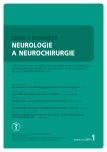Can we accurately diagnose the dyskinetic form of cerebral palsy? YES
Published in:
Cesk Slov Neurol N 2019; 82(1): 16
Category:
Controversions
Sources
1. Bax MC. Terminology and classifi cation of cerebral palsy. Dev Med Child Neurol 1964; 6 : 295–297.
2. Rosenbaum P, Paneth N, Leviton A et al. A report: the definition and classification of cerebral palsy April 2006. Dev Med Child Neurol Suppl 2007; 109 : 8–14.
3. Ashwal S, Russman B, Blasco PA et al. Practice parameter: dia gnostic assessment of the child with cerebral palsy: report of the Quality Standards Subcommittee of the American Academy of Neurology and the Practice Committee of the Child Neurology Society. Neurology 2004; 62(6): 851–863.
4. Bax M, Tydeman C, Flodmark O. Clinical and MRI correlates of cerebral palsy: the European Cerebral Palsy Study. JAMA 2006; 296(13): 1602–1608.
5. Albanese A, Kailash Bhatia K, Bressman SB et al. Phenomenology and classifi cation of dystonia: a consensus update. Mov Disord 2013; 28(7): 863–873.
Labels
Paediatric neurology Neurosurgery NeurologyArticle was published in
Czech and Slovak Neurology and Neurosurgery

2019 Issue 1
- Metamizole vs. Tramadol in Postoperative Analgesia
- Memantine in Dementia Therapy – Current Findings and Possible Future Applications
- Metamizole at a Glance and in Practice – Effective Non-Opioid Analgesic for All Ages
- Advances in the Treatment of Myasthenia Gravis on the Horizon
Most read in this issue
- Mild traumatic brain injury management – consensus statement of the Czech Neurological Society CMS JEP
- Chronic subdural haematoma
- Oligoclonal IgG and free light chains – comparison between agarose and polyacrylamide isoelectric focusing
- Ketogenic diet – effective treatment of childhood and adolescent epilepsies
